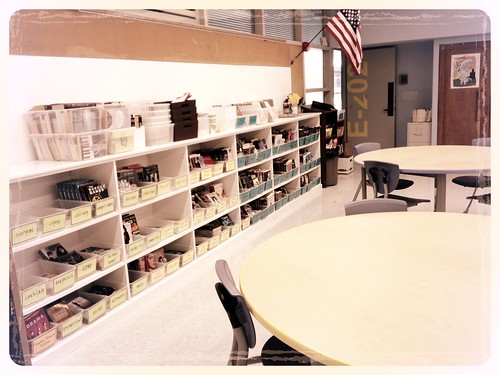As I mentioned a few times, I like to start the year with primarily blank walls and bulletin boards, like this:
 |
| Empty bins = most popular summer titles. |
I'm a big believer in making your charts in front of your students, even if I often have to go back and clean them up (or choose new colors). They still recognize the thinking and talking that we did in class on the walls.
I'm also very much against isolated grammar instruction. I don't do worksheets or sentence diagramming. We don't color code parts of speech. However, the reality is that I teach 8th grade, and some of my students will have cranky grammarians for high school teachers. My students need a grammar vocabulary that isn't necessarily useful in the world at large, but will be essential in the next few years.
If you haven't read Mechanically Inclined by Jeff Anderson, then go get it right now. Even though his students in the book are 4th graders, it will help anyone who is trying to integrate writing and grammar/mechanics.
I use the book Grammar for Middle School: A Sentence-Composing Approach by Don Killgallon with my students. The grammar is pretty fancy (gerunds! absolute phrases! appositives!), but instead of endless drilling, we practice using new types of sentences to expand our skills. (I need to write a longer post on how I use this book when I have more time. I definitely don't follow the order of sentence types in the table of contents.)
I realized a few years ago that this would only work if my students memorized the difference between a phrase and a clause. Even if they still struggle to recognize or use them well, I needed the definition to be automatic, like math facts. I wrote a simple, nine-question test, gave them the key, and had them commit the answers to memory. Last year they ended 7th grade with this test, and so on Tuesday (and Thursday as I have a slightly goofy schedule this year), they took it again. When they were done, I had them switch pens, and I wrote the answers on chart paper on our easel. (They were messy, messy charts. I'm sorry I forgot to take a picture.) Once both classes were done, I spent some time after school copying the messy info into something that they can copy into their writer's notebooks.
 |
| I'm not capable of making charts fancier than these. |
I will leave these charts hanging until the test next week, and then put them up again until we need the space for something else.
This is much better than anything I could have done with butcher paper.
 |
| Messy anchor charts start here. |
I would love for you to blog more about how you use the Killgallon book. I own it but have spent the past year trying to make it fit in my class. Thanks!
ReplyDeletethecurlyclassroom.blogspot.com
Definitely! We haven't started using it yet, but I'll share when I do. Last year we did words (opening and delayed adjectives and adverbs), then clauses (actually easier), then phrases (prepositional then appositives). We definitely left gerunds/infinitives/participials for the end, and skipped absolute phrases. That alone made a big difference.
Delete